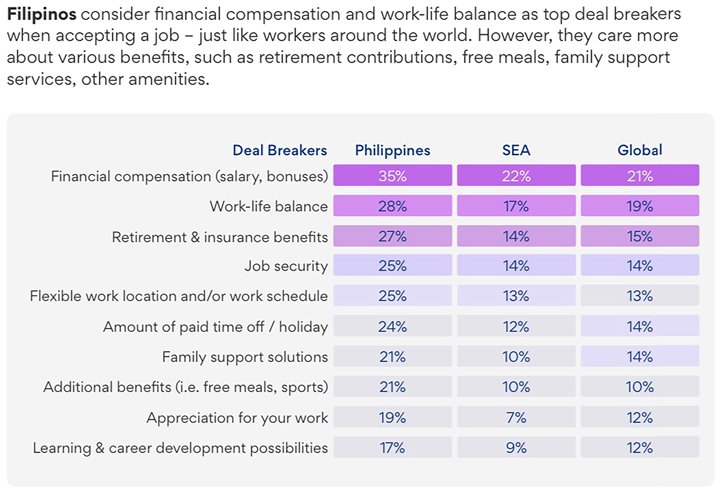BIRTHDAY leaves, menstrual leaves, family insurance, internet allowance, retirement plans—these are among the enhancements in benefits packages companies are recommended to adopt to be able to retain talented and motivated employees.
According to JobStreet’s Hiring, Compensation & Benefits Report 2024, companies should conduct more frequent and comprehensive reviews to enhance their compensation and benefits strategy. “Many companies only focus on factors like salary benchmarking and evaluating pay guidelines but there is room for more proactive measures. Use benefits benchmarks to conduct simple internal surveys to gauge employee sentiments and needs. These cost-effective and efficient methods can significantly contribute to improving your compensation and benefits structure.”
To make “impactful changes” in the lives of their employees, companies may consider the following benefits to attract or retain their workforce: (Special leaves) birthday leave, menstrual, family care leave; (Financial benefits) medical health treatment coverage/insurance, pension funds/retirement plan; (Career development) apprenticeship/mentoring program, education allowance/sponsorship; (Family Friendly) medical protection/insurance for family members, medical checkups, activities extended to family members; and other benefits such as internet allowance and travel allowance.
With the workforce getting younger, would-be employees are getting more picky about the companies in which they choose to work. According to JobStreet, “deal breakers” include financial compensation such as salaries and bonuses (35 percent), work-life balance (28 percent), job security (25 percent), flexible work location and/or work schedule (25 percent), among others, with learning and career development possibilities ranking lowest at just 17 percent.

Mental-health support
Companies also need to enhance their efforts to boost employee morale and support those experiencing stress within their offices. “It’s crucial to provide ample support for employees navigating stressful situations. Consider prioritizing work-life balance benefits to address this need. Top recommendations include offering mental health or wellness counseling/talks and implementing an employee assistance program. These initiatives can significantly contribute to creating a supportive and healthier work environment.”
Most hirers in JobStreet’s survey indicated the top causes of moderate stress in their companies include: heavy workload (36 percent) and high pressure from the management or the fast work pace (28 percent). “Issues such as lack of appreciation/recognition (42 percent), low pay (34 percent), long working hours (35 percent), high turnover/resignations (37 percent), and too much hierarchy (29 percent) are more prevalent in companies in the high stress zone.”
Less hiring in 2024
The survey indicated the jobs market in the country, while overall positive, is projected to soften by the second half of the year, due to local economic and global developments.
JobStreet’s report said: “61 percent of the hirers surveyed displayed confidence that the job market will be more active during [the first half] of the year 2024—reflecting an optimistic overall outlook of more hiring by businesses and active jobhunting by candidates. However, there is a noticeable decline in confidence for the second half of 2024, dropping to 41 percent. This decline is attributed to a higher degree of uncertainty, with 16 percent of hirers mentioning their uncertainty about the job market’s outlook during that period—which could be influenced by various factors, including economic conditions and global events.”
Jobstreet surveyed 685 hiring executives across the country in September 2023 in industries such as computer/infomation technology (12 percent); manufacturing (10 percent); retail and trade (10 percent); consumer services (9 percent); business services (8 percent); education, social services, healthcare (8 percent); construction/industrial equipment and machinery (7 percent); banking, finance, insurance (7 percent); industrial goods/raw materials (6 percent); electrical, electronics and telecommunications (4 percent), media and advertising (2 percent), and others (14 percent).










